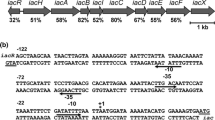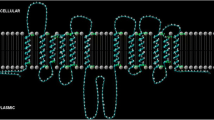Abstract
The lactococcal plasmid pCIT264 contains a cluster of three genes (citQ, citR andcitP) involved in the transport of citrate inLactococcus lactis biovardiacetylactis. Thecit cluster contains a copy of a newly discovered insertion sequence (IS)-like element located between its promoter P1 and the first gene of the cluster. In this report, we show that this IS-like element can act as a mobile switch for the downstream genes, creating two new transcriptional promoters named P2 and P2′. The P2 promoter is recognized by the lactococcal RNA polymerase in vivo. This is a hybrid promoter composed of a −35 region reading outwards 12 bp from the right end of the IS-like element, and a nucleotide sequence from the recipient plasmid, adjacent to the element, which provides an appropriately spaced −10 region. Transcription of thecitQRP cluster from this promoter takes place during the exponential and stationary phases of growth inL. lactis. Promoter P2′ is included in the IS-like element and is the only promoter responsible for expression ofcitP inE. coli. Thus, it appears that the introduction of this element into pCIT264 allows expression of thecitQRP cluster inE. coli, and increases its levels of expression inL. lactis.
Similar content being viewed by others
References
Amábile-Cuevas CF, Chicurel ME (1992) Bacterial plasmids and gene flux. Cell 70:189–199
Cluzel PJ, Chopin A, Ehrlich SD, Chopin MC (1991) Phage abortive infection mechanism fromLactococcus lactis subsp.lactis expression of which is mediated by an iso-ISS1 element. Appl Envir Microbiol 57:3547–3551
d'Aubenton-Carafa YD, Brody E, Thermes C (1990) Prediction of Rho-independentEscherichia coli transcription terminators. A statistical analysis of their RNA stem-loop structures. J Mol Biol 216:835–858
David S, van der Rest ME, Driessen AJM, Simmons G, de Vos WM (1990) Nucleotide sequence and expression inEscherichia coli of theLactococcus lactis citrate permease gene. J Bacteriol 172:5789–5794
Dornan S, Collins MA (1990) High efficiency electroporation ofL. lactis susp.lactis LM0230. Letters in Appl Microbiol 110:62–64
Galas DJ, Chandler M (1989) Bacterial insertion sequences. In: Berg DE, Howe MM (eds) Mobile DNA. American Society for Microbiology, Washington DC, pp 109–162
Gasson MJ (1983) Plasmid complements ofStreptococcus lactis NCDO 712 and other streptococci after protoplast-induced curing. J Bacteriol 154:1–9
Gasson MJ (1993) Progress and potential in the biotechnology of lactic acid bacteria. FEMS Microbiol Rev 12:3–20
Jordan E, Saedler H, Starlinger P (1968) O-zero and strong polar mutations in thegal operon are insertions. Mol Gen Genet 102:353–363
Harvey RJ, Collins EB (1962) Citrate transport system ofStreptococcus diacetylactis. J Bacteriol 83:1005–1009
Hugenholtz J, Perdon L, Abee T (1993) Growth and energy generation byLactococcus lactis subsp.lactis biovardiacetylactis during citrate metabolism. J Bacteriol 59:4216–4222
Labes G, Simon R (1990) Isolation of DNA insertion elements fromRhizobium meliloti which are able to promote transcription of adjacent genes. Plasmid 24:235–239
Lacks SA (1970) Mutants ofDiplococcus pneumoniae that lack deoxyribonucleases and other activities possibly pertinent to genetic transformation. J Bacteriol 101:373–383
Lacks SA, López P, Greenberg B, Espinosa M (1986) Identification and analysis of genes for tetracycline resistance and replication functions in the broad-host-range plasmid pLS1. J Mol Biol 192:753–765
López P, Espinosa M, Lacks SA (1984) Physical structure and genetic expression of sulfonamide-resistance plasmid pLS80 and its derivatives inStreptococcus pneumoniae andBacillus subtilis. Mol Gen Genet 195:402–410
López P, Díaz A, Espinosa M, Lacks SA (1989) Characterization of thepolA gene ofStreptococcus pneumoniae and comparison of the DNA polymerase I it encodes to homologous enzymes fromE. coli and phage T7. J Biol Chem 264:4255–4263
López de Felipe F, Corrales MA, López P (1994) Comparative analysis of gene expression inStreptococcus pneumoniae andLactococcus lactis. FEMS Microbiol Lett 122:289–296
López de Felipe F, Magni C, de Mendoza D, López P (1995) Citrate utilization gene cluster of theLactococcus lactis biovardiacetylactis: organization and regulation of expression. Mol Gen Genet 246:590–599
Magni C, López de Felipe F, Sesma F, López P, de Mendoza D (1994) Citrate transport inLactococcus lactis subsp.lactis biovardiacetylactis. Expression of the citrate permease P. FEMS Microbiol Lett 118:75–82
Magni C, López de Felipe F, López P, de Mendoza D (1996) Characterization of an insertion sequence-like element identified in plasmid pCIT264 fromLactococcus lactis subsp. biovardiacetylactis. FEMS Microbiol Lett. In press
Prentki P, Teter B, Chandler M, Galas DJ (1986) Functional promoters created by the insertion of transposable element IS1. J Mol Biol 191:383–393
Rosenberg M, Court D (1979) Regulatory sequences involved in the promotion and termination of RNA-transcription. Annu Rev Genet 13:319–53
Sambrook J, Fritsch EF, Maniatis T (1989) Molecular cloning, a laboratory manual, 2nd edn. Cold Spring Harbor Laboratory, Cold Spring Harbor, New York
Sanger F, Nicklen S, Coulson AR (1977) DNA sequencing with chain-terminating inhibitors. Proc Natl Acad Sci USA 74:5463–5467
Sesma F, Gardiol D, de Ruiz Holgado AP, de Mendoza D (1990) Cloning and expression of the citrate permease gene ofLactococcus lactis subsp.lactis biovardiacetylactis inEscherichia coli. Appl Envir Microbiol 56:2099–2103
Smith M, Hugenholz J, Mikóczi P, de Ree E, Bunch W, de Vont J (1992) The stability of the lactose and citrate plasmids inLactococcus lactis biovardiacetylactis. FEMS Microbiol Lett 96:7–12
Starrenburg MJC, Hugenholtz J (1991) Citrate fermentation byLactococcus andLeuconostoc spp. Appl Envir Microbiol 57:3535–3540
Studier FW, Moffat BA (1986) Use of the T7 RNA polymerase to direct expression of cloned genes. J Mol Biol 189:113–130
Van de Guchte M, Kok J, Venema G (1992) Gene expression inLactococcus lactis. FEMS Microbiol Rev 88:73–92
Van Rooijen RJ, de Vos WM (1990) Molecular cloning, transcriptional analysis and nucleotide sequence oflacR, a gene encoding the repressor of the lactose phosphotransferase system ofLactococcus lactis. J Biol Chem 265:18499–18503
Author information
Authors and Affiliations
Additional information
Communicated by B. J. Kilbey
Rights and permissions
About this article
Cite this article
de Felipe, F.L., López, P., Magni, C. et al. Transcriptional activation of the citrate permease P gene ofLactococcus lactis biovardiacetylactis by an insertion sequence-like element present in plasmid pCIT264. Molec. Gen. Genet. 250, 428–436 (1996). https://doi.org/10.1007/BF02174031
Received:
Accepted:
Issue Date:
DOI: https://doi.org/10.1007/BF02174031




